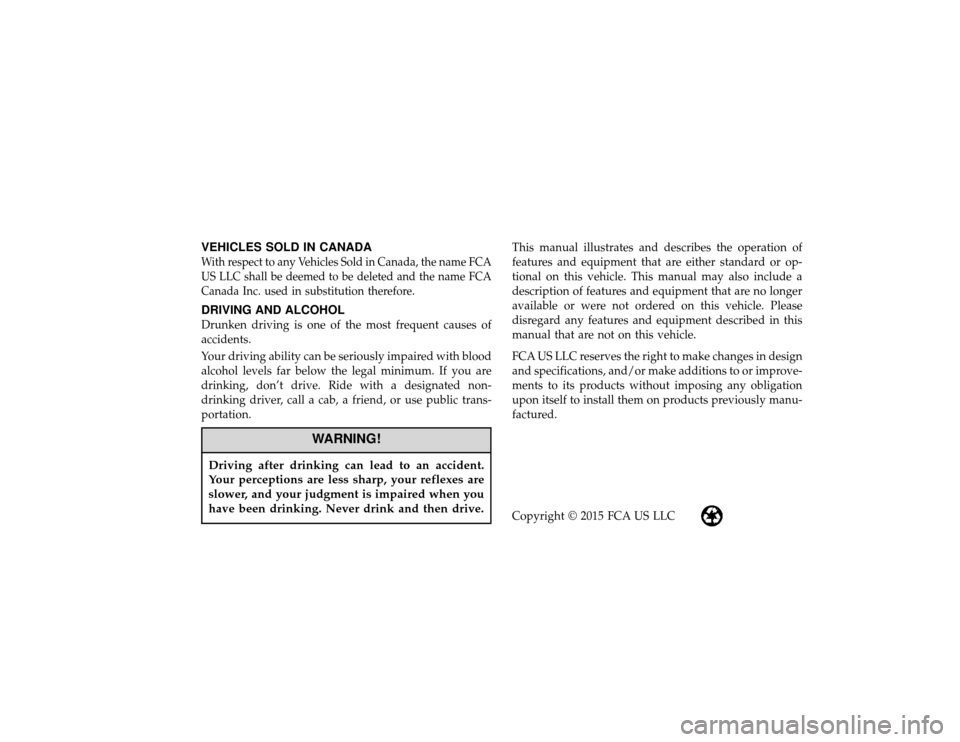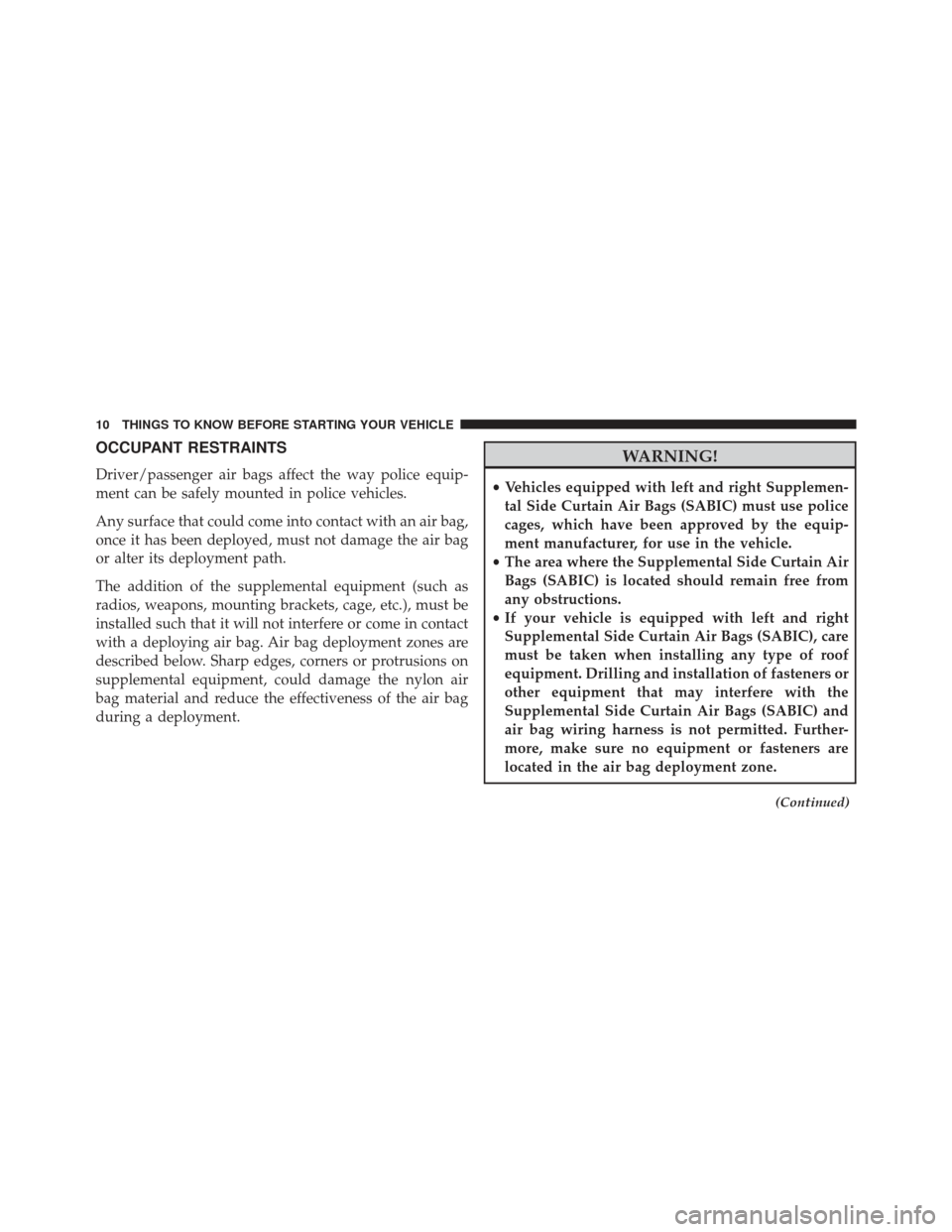Page 2 of 34

VEHICLES SOLD IN CANADAWith respect to any Vehicles Sold in Canada, the name FCA
US LLC shall be deemed to be deleted and the name FCA
Canada Inc. used in substitution therefore.DRIVING AND ALCOHOLDrunken driving is one of the most frequent causes of
accidents.
Your driving ability can be seriously impaired with blood
alcohol levels far below the legal minimum. If you are
drinking, don’t drive. Ride with a designated non-
drinking driver, call a cab, a friend, or use public trans-
portation.
WARNING!
Driving after drinking can lead to an accident.
Your perceptions are less sharp, your reflexes are
slower, and your judgment is impaired when you
have been drinking. Never drink and then drive.
This manual illustrates and describes the operation of
features and equipment that are either standard or op-
tional on this vehicle. This manual may also include a
description of features and equipment that are no longer
available or were not ordered on this vehicle. Please
disregard any features and equipment described in this
manual that are not on this vehicle.
FCA US LLC reserves the right to make changes in design
and specifications, and/or make additions to or improve-
ments to its products without imposing any obligation
upon itself to install them on products previously manu-
factured.
Copyright © 2015 FCA US LLC
Page 8 of 34
DOOR LOCKS
Manual Door Locks
The power door locks can be manually locked from
inside the vehicle by using the door lock knob. To lock
each door, push the door lock knob on each door trim
panel downward. To unlock the front doors, pull the
inside door handle to the first detent. For Police vehicle,
both rear passenger doors are inoperable from the rear
seat position, inside of the vehicle. If the lock knob is
down when the door is closed, the door will lock.
Therefore, make sure the key is not inside the vehicle
before closing the door.
WARNING!
•For personal security and safety in the event of an
collision, lock the vehicle doors as you drive as
well as when you park and leave the vehicle.
(Continued)
Manual Door Lock Knob
6 THINGS TO KNOW BEFORE STARTING YOUR VEHICLE
Page 9 of 34
WARNING!(Continued)
•Never leave children alone in a vehicle, or with
access to an unlocked vehicle. Allowing children to
be in a vehicle unattended is dangerous for a
number of reasons. A child or others could be
seriously or fatally injured. Children should be
warned not to touch the parking brake, brake pedal
or the gear selector.
• Do not leave the key fob in or near the vehicle, or
in a location accessible to children, and do not
leave the ignition of a vehicle equipped with
Keyless Enter-N-Go in the ACC or ON/RUN mode.
A child could operate power windows, other con-
trols, or move the vehicle.
Power Door Locks
The power door lock switch is located on each front door
panel. Push the switch to lock or unlock the doors.
If the lock knob is down when the door is closed, the door
will lock. Therefore, make sure the key fob is not inside
the vehicle before closing the door.
Power Door Lock Switch
2
THINGS TO KNOW BEFORE STARTING YOUR VEHICLE 7
Page 12 of 34

OCCUPANT RESTRAINTS
Driver/passenger air bags affect the way police equip-
ment can be safely mounted in police vehicles.
Any surface that could come into contact with an air bag,
once it has been deployed, must not damage the air bag
or alter its deployment path.
The addition of the supplemental equipment (such as
radios, weapons, mounting brackets, cage, etc.), must be
installed such that it will not interfere or come in contact
with a deploying air bag. Air bag deployment zones are
described below. Sharp edges, corners or protrusions on
supplemental equipment, could damage the nylon air
bag material and reduce the effectiveness of the air bag
during a deployment.
WARNING!
•Vehicles equipped with left and right Supplemen-
tal Side Curtain Air Bags (SABIC) must use police
cages, which have been approved by the equip-
ment manufacturer, for use in the vehicle.
• The area where the Supplemental Side Curtain Air
Bags (SABIC) is located should remain free from
any obstructions.
• If your vehicle is equipped with left and right
Supplemental Side Curtain Air Bags (SABIC), care
must be taken when installing any type of roof
equipment. Drilling and installation of fasteners or
other equipment that may interfere with the
Supplemental Side Curtain Air Bags (SABIC) and
air bag wiring harness is not permitted. Further-
more, make sure no equipment or fasteners are
located in the air bag deployment zone.
(Continued)
10 THINGS TO KNOW BEFORE STARTING YOUR VEHICLE
Page 13 of 34
WARNING!(Continued)
•Do not place objects or mount equipment in front
of the air bag module cover, or in front of the seat
areas that may come in contact with a deploying air
bag.
• Dash, tunnel or console mounted equipment
should not be placed outside of the specified zone.
• Failure to follow these instructions could result in
personal injury.
Air Bag Deployment Zones
There are four zones to be aware of:
1.
Driver Air Bag Deployment Zone (Figure 1), and Driver
Air Bag/Steering Wheel Specifications (Figure 2)
2. Passenger Air Bag Deployment Zone (Figure 3) and (Figure 4)
3. Supplemental Side Air Bag Inflatable Curtain (SABIC) Deployment Zone (Figure 5)
4. Supplemental Seat-Mounted Side Air Bag (SAB) De- ployment Zone (Figure 6)
2
THINGS TO KNOW BEFORE STARTING YOUR VEHICLE 11